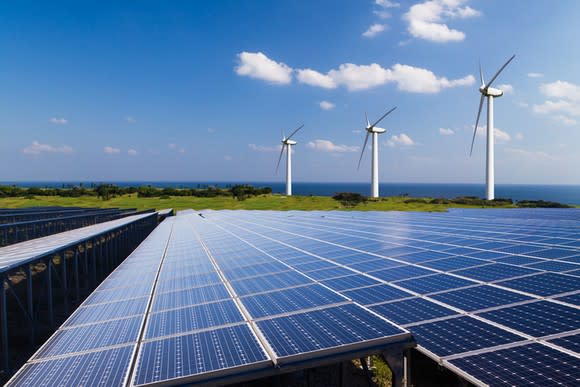5 Energy Dividend Stocks You Can Buy Right Now
Energy is critically important to the modern world, and many of the companies involved generate large, steady cash flows that make them ideal dividend stocks. But at the same time, there are plenty of energy stocks investors would do well to avoid.
If you're looking for the best energy dividend stocks, it's important to understand the different sectors of the energy industry, so you can find companies that can keep paying you regularly and avoid the ones that may struggle to maintain a dividend. Let's take a closer look at what you need to know about the energy industry, and identify some of the best energy dividend stocks you can buy right now.
The three best dividend stocks in oil and gas
One of the most important characteristics of a company with a reliable dividend stock is steady, recurring cash flow. And while there are plenty of companies in oil and gas that generate solid cash flows, there are even more with revenues that swing wildly, which can make it difficult to pay a reliable dividend. Let's take a closer look at the different subsectors of oil and gas, which can be divided into three main parts: upstream, midstream, and downstream.

Image source: Getty Images.
Companies that engage in upstream operations, also called exploration and production (or just E&P), search for and extract oil and gas. These companies make a living selling oil to downstream companies, which operate the refineries and petrochemical plants that turn oil and gas into gasoline, motor oil, jet fuel, fertilizers, rubber, plastics, and the many other goods made from hydrocarbons. The gathering systems and pipelines that connect oil fields to downstream facilities belong to midstream companies; they're contracted by both upstream and downstream companies to gather, transport, and store oil and gas.
Among these three segments, the upstream companies have the most exposure to commodity prices. When oil is expensive, they can be incredibly profitable. But when oil prices fall, big profits can turn into even bigger losses very quickly. In general, this means oil and gas producers aren't ideal dividend investments. Midstream and some downstream companies, on the other hand, can be great dividend investments, since they are far less exposed to commodity swings than their E&P brethren.
There are also integrated oil and gas companies, which have operations in more than one segment of the oil and gas industry. These more diversified companies can also be solid dividend investments.
Here are the three oil and gas dividend stocks that make my list as worth buying today:
Company | Subsector | Dividend Yield |
|---|---|---|
Royal Dutch Shell plc (ADR) (NYSE: RDS-A) (NYSE: RDS-B) | Integrated major | 5.8% |
Phillips 66 (NYSE: PSX) | Midstream, downstream | 2.9% |
ONEOK, Inc. (NYSE: OKE) | Midstream | 5.7% |
Why do these companies make the list? In short: They are well-established; they generate strong cash flows; and they offer a strong yield, a history of dividend growth, or both.
Shell, for instance, is the second-biggest public oil company trading on U.S. markets, and is one of the biggest public companies you can buy following its 2016 acquisition of BG Group. Since that acquisition, management has implemented a rigorous plan to cut costs and become more return-oriented, and the evidence is pretty clear that it's working.

Image source: Getty Images.
The company still has a long way to go to bring down its debt from the BG acquisition, but it has proved it can be a very profitable company in the current price environment, and that bodes well for the company's ability to maintain the dividend while also improving its balance sheet. Shell may not be able to increase its payout anytime soon -- paying down debt is a better use of capital at present -- but for now, its yield near 6% makes up for that.
Phillips 66 is also an integrated oil and gas giant. Mostly known for its refining and retail gasoline operations, Phillips 66 also owns and operates substantial gathering and pipeline systems, and storage and export facilities; through its joint venture with Chevron, CPChem (Chevron Phillips Chemical Company), it is one of the biggest petrochemical manufacturers on the planet.
What is unique about Phillips 66 is that, even though it participates in many parts of the oil and gas value chain, it is a consumer, not a producer. That means cheap oil and gas are actually good things for the company, helping to make its export and chemical operations more competitive on a global basis. It's also somewhat immune from rising prices, since its midstream operations are largely fee-based businesses, and its refined products generally sell at prices pegged to Brent crude.

Image source: Getty Images.
While it may only yield 2.9% at recent prices, Phillips 66 also has a strong track record of dividend growth. That's likely to continue; the company just announced it will spend $1.4 billion -- about two thirds of its outlay for capital expenditures -- on growth projects in 2018.
ONEOK makes the list as a more specialized company, primarily operating natural gas and NGL (natural gas liquids) gathering systems and pipelines. A few years ago, ONEOK wasn't nearly as safe a dividend investment, since much of its gathering revenue was tied to commodity prices. Since that time, however, the company has moved nearly all of its gathering agreements to fixed-price contracts. This may reduce the upside if prices shoot up, but it significantly reduced the downside, while also adding a big measure of predictability.
But that doesn't mean there won't be any growth -- far from it. Management anticipates it will spend as much as $3.5 billion on growth projects over the next five years or so, and plans to recommend annual dividend increases close to 10% for the foreseeable future.
Two energy dividend stocks with amazing long-term prospects
Even as oil and gas remain huge sources of global energy, renewables are coming on strong. And it's not just because of a desire to reduce carbon emissions and air pollution; it's because renewables are getting cheaper than fossil fuels. Solar and wind are now consistently cheaper than coal and nuclear; in many cases they're cheaper than natural gas, and the costs are going to keep falling. Energy storage -- the missing puzzle piece for renewables to completely disrupt fossil fuels -- is getting cheap enough to make financial sense for utilities and industrial power users alike.

Image source: Getty Images.
This puts Pattern Energy Group Inc. (NASDAQ: PEGI) and 8Point3 Energy Partners LP (NASDAQ: CAFD) in strong positions to supply energy to utilities and large consumers, and reward investors handsomely.
There are some differences between the two. Pattern Energy Group has generally owned stakes in wind farms, but its future strategy includes investments in solar, energy storage, and power transmission projects to connect its production to the grid. Between 2017 and 2020, the company plans to double its capacity, and it has access to a substantial pipeline of new projects through its privately held parent company, Pattern Development, that put this goal within reach. Since it was taken public in 2012, investment in new projects has yielded 163% growth in capacity, and that has pushed cash available for distribution 258% higher. With a current yield of 7.9% and very good prospects to grow the payout in coming years, Pattern Energy is one of my favorite dividend stocks to buy.
8Point3 Energy Partners is a pure-play solar project investment. A joint project of First Solar (NASDAQ: FSLR) and SunPower (NASDAQ: SPWR), the master limited partnership was originally founded as a way for those companies to monetize their own commercial and utility-scale solar projects. The intent was to sell most of the large-scale solar projects they would build to 8Point3, while 8Point3 would then operate the projects and sell the power. This would make it easy for First Solar and SunPower to make a quick profit on the projects, while also getting some of the profit from the energy production via the distributions paid by 8Point3.

Image source: Getty Images.
More recently, both First Solar and SunPower have announced their intention to sell their stakes, creating uncertainty for the partnership. SunPower is putting less focus on building the big projects that 8Point3 owns, while First Solar says that the market is big enough for it not to need 8Point3 as a project buyer.
In the near term, the uncertainty around what the two sponsors will do with their stakes could weigh on 8Point3, but with a dividend yield of 7.5%, and what should be plenty of opportunities to invest in new solar projects in the future, its long-term prospects remain very good.
The big-picture view is this: Fossil fuels are likely to continue playing a big role in powering the world for years to come, and that bodes well for Shell, ONEOK, and Phillips 66. But renewables are coming on strong as prices fall and energy storage becomes a reality. For investors looking to profit from both the present and the future of energy, Pattern Energy Group and 8Point3 Energy Partners round out a strong collection of energy dividend stocks that investors should put on their shopping lists.
More From The Motley Fool
6 Years Later, 6 Charts That Show How Far Apple, Inc. Has Come Since Steve Jobs' Passing
Why You're Smart to Buy Shopify Inc. (US) -- Despite Citron's Report
Jason Hall owns shares of 8point3 Energy Partners, First Solar, ONEOK, Pattern Energy Group, Phillips 66, Royal Dutch Shell (B Shares), and SunPower. The Motley Fool owns shares of and recommends ONEOK. The Motley Fool recommends First Solar. The Motley Fool has a disclosure policy.

 Yahoo Finance
Yahoo Finance 